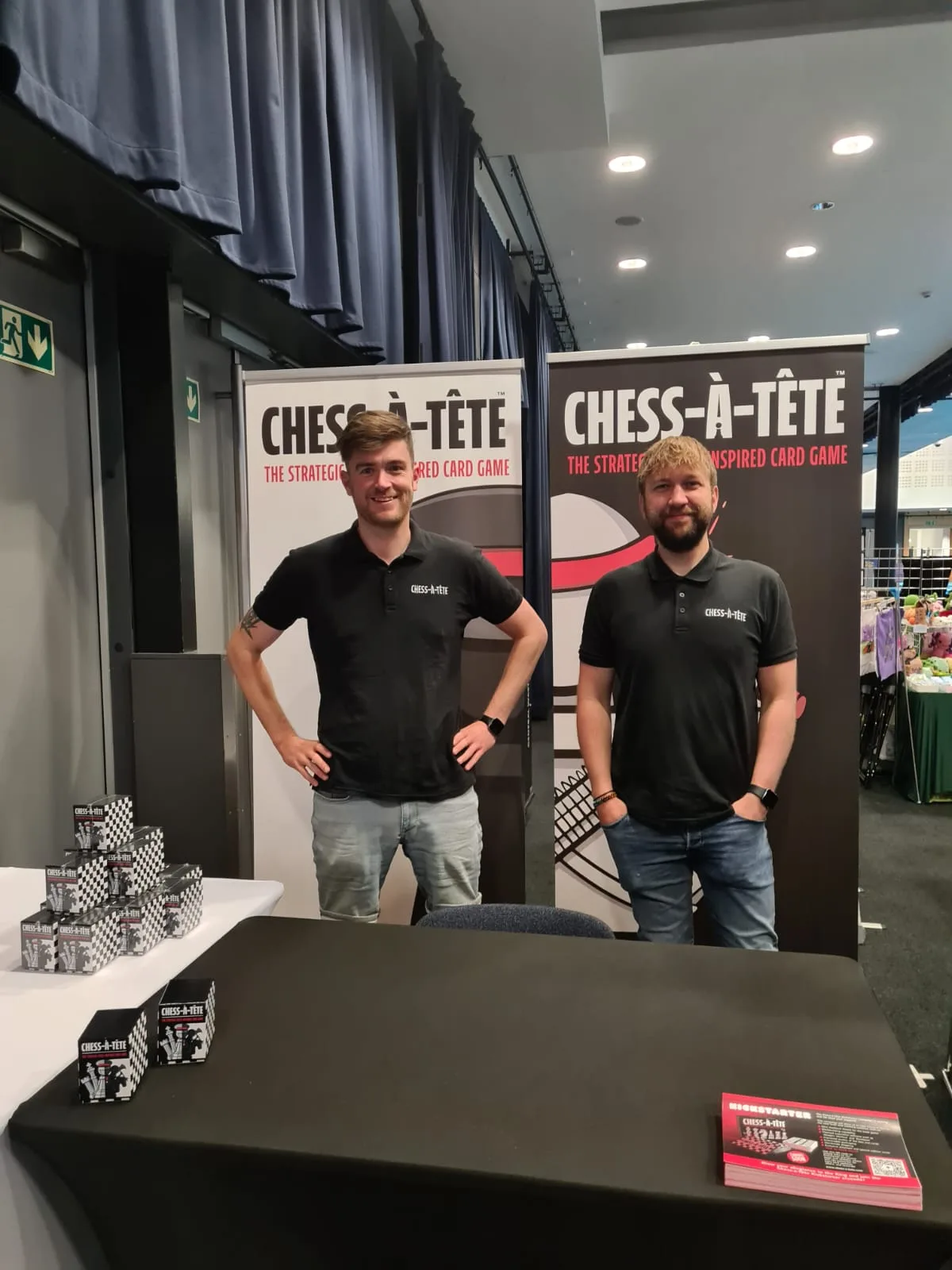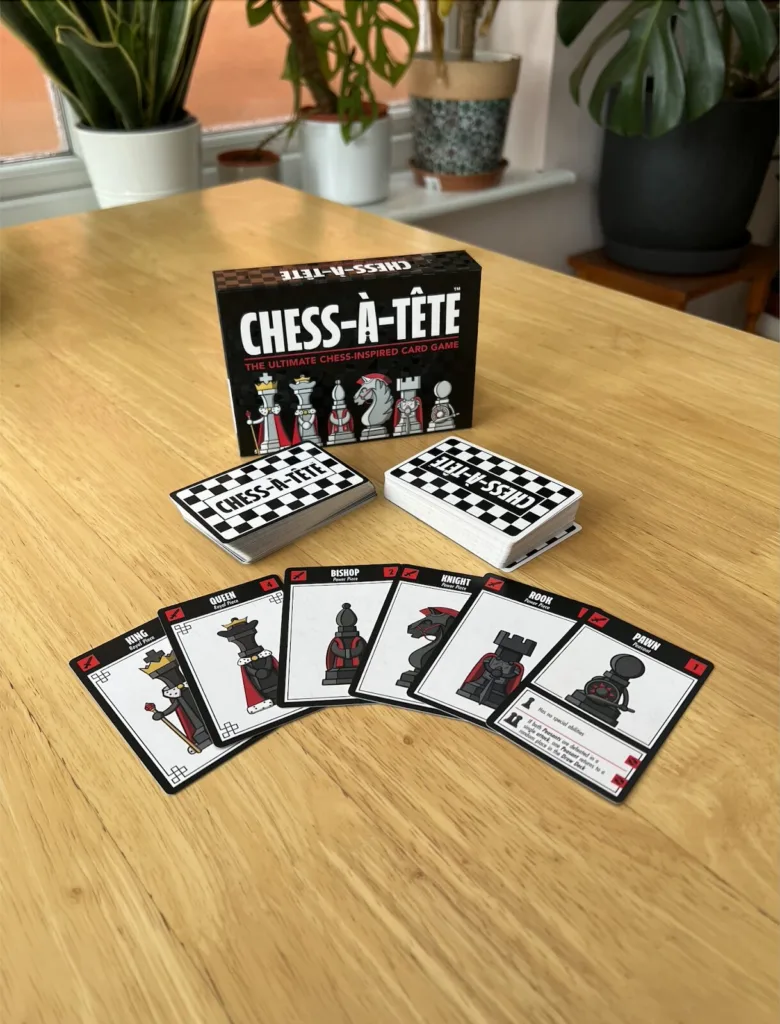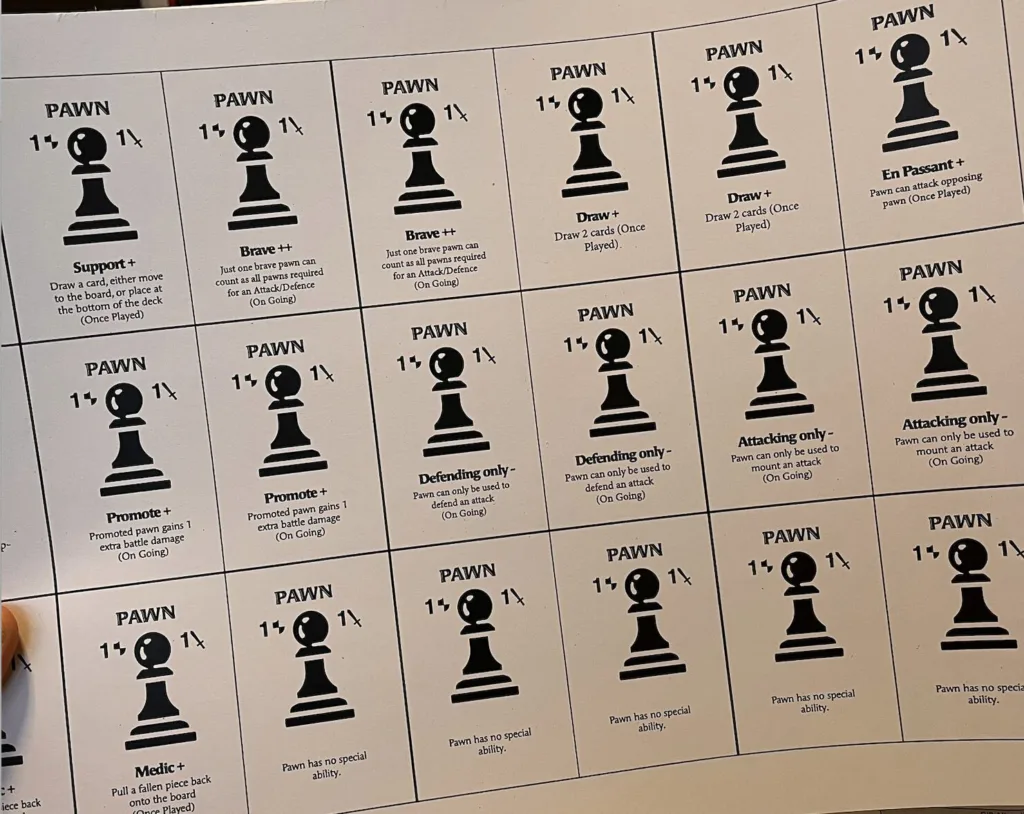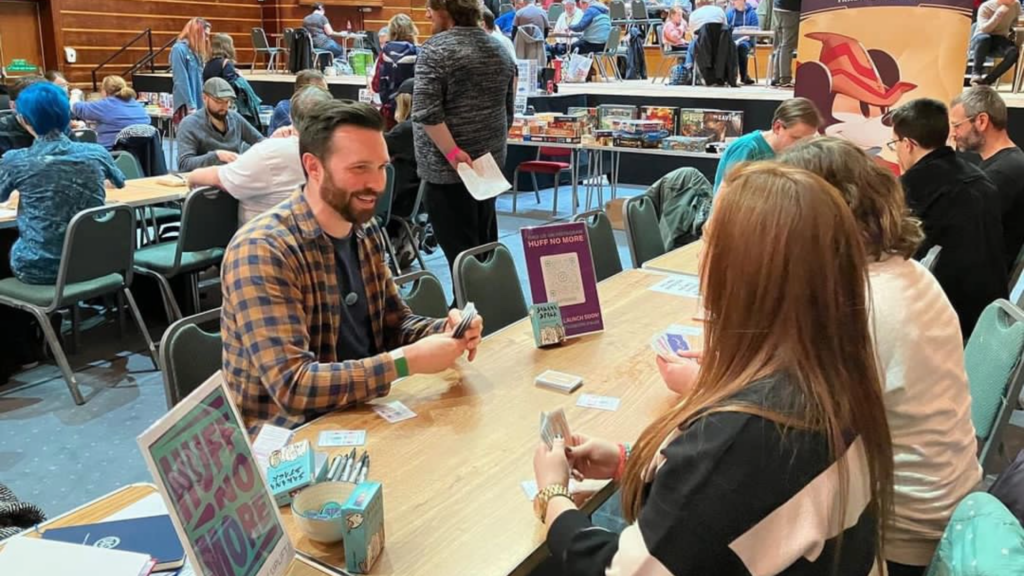Welcome to another What If blog, where we dive into the fascinating journeys behind indie tabletop games! Today I’m joined by Sam, co-creator of Chess-à-Tête, a chess-inspired card game that recently smashed its Kickstarter goal. What makes this interview special is that we’re following Sam’s journey in real-time – from pre-launch jitters through to funding in just 14 hours and ultimately reaching 400% of their target.
If you’re curious about how to transform a simple idea into crowdfunding success while juggling a full-time job, you’re in for a treat. Let’s dive in!
Joe: Welcome to the What If blog! Can you start with a short introduction, who are you and what brings you to the world of board games design?
Sam: Hi Joe, I’m Sam, one half of the partnership behind Chess-a-Tête, a chess-inspired card game, co-created with my childhood best friend, Mitchell. Like many others in game design, our journey began with a “cool idea” we couldn’t ignore!

Joe: That feels like a good place to start, and I’m always really interested in ideas and where they come from – can you remember how the idea came about? What was the inspiration? How did you know it was the idea?
Sam: I wasn’t there for the actual “lightbulb” moment, but rumour has it that Mitch came up with the idea and the entire gameplay during a long drive from North to South. He shared the idea with me in January 2023, as we have been collaborating on projects for years ever since we worked on a comic book together: Jumping Jack when we were 15. I immediately loved the idea. I had been wanting to dive into a game design project for a while, so I jumped right in and started sketching out some designs for the first paper prototypes.
Joe: Great. Tell us about Chess-à-Tête then, what’s the game all about?
Sam: Chess-à-Tête is a two-player, chess-inspired card game where your ultimate goal, just like in traditional chess, is to defeat your opponent’s King. Instead of moving pieces on a board, you’ll draw cards to build an army of Pawns, Knights, Bishops, and the Queen. Using these pieces, you’ll engage your opponent in tactical battles with combat cards and shift the momentum with powerful, game-changing action cards. The game will call upon your strategic thinking, luck, and wits.
Like many others in game design, our journey began with a ‘cool idea’ we couldn’t ignore!
While the theme is rooted in the strategic essence of chess, Chess-à-Tête features its own unique card-battling gameplay, so you don’t need to know or enjoy chess to play. The game strikes a balance between strategy and casual fun, and with our deck-building capability, players can delve deeper into the strategic side if they choose.
Joe: I was lucky enough to play last summer at Airecon and really enjoyed the game. With the game being thematically linked to chess, which I imagine comes with some baggage, how have you found people are finding Chess-a-Tête? Do you find people are initially scared that it might be full chess?
Sam: So far, we haven’t seen many people put off by the chess connection. I think this is because we’ve intentionally taken the illustrations and branding in a more modern direction, giving the game its own unique identity, which seems to spark curiosity among both general gamers and chess enthusiasts.

While the name, characters, and some mechanical elements hint at chess, the gameplay itself is entirely different, it’s more of a casual and fun deck-building battle game. From the start, our goal was for Chess-à-Tête to stand on its own merits, separate from traditional chess. After all, you can’t really compete with one of the oldest and most loved games in history, can you? Chess lovers are often surprised and relieved to find that we haven’t simply tried to rework or ‘improve’ their cherished game.
Joe: I do love your anthropomorphised characters in the deck! You’re obviously having a lot of fun creating the artwork for the game.
This is your first game, and I’m wondering if we might talk a little about the process of creating a game from your idea to where you are now. What have you found to be most challenging about board game design?
Sam: Thanks! I’m glad you like them, creating the characters has been a lot of fun. Taking the game from that first “lightbulb” moment to two years of development has been quite a journey.
We started with paper tests to trial the mechanics, then focused on nailing the design and illustrations. In such a competitive market, the brand’s look is almost as important as the gameplay, I mean, what’s the point of having the greatest game ever inside a box no-one would ever pick up? So once we had a clear direction, I designed the cards, box, and instructions. After testing and refining some more we then printed 1,000 copies. Our initial approach was simple: make the game, sell the game. Which to be fair, kind of worked and it sold well!
Once we had our copies, we hit the road to spread the word about Chess-a-Tête, attending conventions and playtest events across the country. These events became the core of our playtesting, aside from sessions with friends and ourselves. Naturally, this process revealed plenty of areas for improvement.

We also started speaking with other designers and learned about Kickstarter, which was new to us at the time. Since we were already planning to improve and reprint the game, we decided to reinvest the profits from the first edition into a Kickstarter relaunch for the new and improved Chess-a-Tête. Whether Kickstarter was the right move, or if we should’ve stuck with the “make and sell” approach remains to be seen, but it’s allowed us to refine the game far more than if we’d simply tweaked and reprinted. I guess we’ll find out in March!
To pick one challenge through this journey is difficult as there are many! But one very persistent challenge is time. Having the time to do all of this while working full-time is hard, but when you are passionate about something it definitely makes it easier, although I can’t help thinking how much better the game would be if I could work on it full-time…. Maybe one day!
Joe: I recognise that – time, especially when it’s not your 9-5 can be hard to find. I feel lucky that my design process is enjoyable, so much so that I don’t mind putting the time in – it’s better than TV sometimes.
Let’s move onto your Kickstarter campaign and your plans for that. You’ve chosen March as a launch date – what’s on your to-do list leading up to that?
Sam: Yeah, I think as long as you pace yourself, finding the time can be easy and even enjoyable. But as we’re seeing now, things can get pretty hectic in the lead-up to a launch!
We’re all set for March. Originally, we aimed for last October, but as we kept coming up with new ideas for additions and improvements, we realised we needed more time to give the game the best possible launch rather than rushing it.
Right now, we’re almost ready. The game samples are in from the printer, so we’re currently playtesting those and sending them out for previews. That’s the biggest part done… the actual game itself! Now, it’s all the other things in a campaign, I’m designing the campaign story, we’re working with an animated video producer for our Kickstarter video (which is coming together beautifully), and we’re collaborating with an artist on some additional illustrations. We’re also getting everything proofread, and playtesting and finalising our six expansion packs!
Meanwhile, Mitchell, the other half of the business (the boring half) is handling shipping, fulfilment, and finance. So yeah, there’s still quite a lot left to do. February is definitely going to be filled with long days and late nights.
Joe: Busy busy! I’m looking forward to the launch. If we could dive a little deeper, that would be excellent.
I’ve been exploring crowdfunding routes for my games, and the bit that always stops me in my tracks is the maths around mailing lists and prelaunch support. I never believe I’ll have enough support before a launch to get the thing funded.
I wonder if you could explore your experiences of this – how have you been finding potential backers? And how will you find the rest you need?
Sam: Yeah, I agree getting subscribers and pre-launch followers can be pretty daunting. We’ve been steadily building ours over the last six months, testing various marketing approaches. One thing has become very clear from our experience: if you want results, you really have to spend money.
You can spend countless unpaid hours creating amazing content, only to get the same level of engagement you’d get by putting a few pounds behind a single, well-targeted ad.
Gaining followers organically works to a point, but I don’t think social media platforms are set up for organic growth the way they used to be. Most of our organic followers come from follow-backs by other game designers, so we’re not really reaching the general public that way. I know not everyone can afford to spend much on ads, we can’t either as an indie startup. But honestly, we can’t really afford the time either. You can spend countless unpaid hours creating amazing content, only to get the same level of engagement you’d get by putting a few pounds behind a single, well-targeted ad.

Our most successful strategies for gaining email subscribers and followers have been through paid ads and in-person playtesting events at conventions or local cafés. These events don’t just help with marketing your game, they also provide valuable opportunities to test the game, so you’re hitting two birds with one stone.
Giveaways have also been effective for us. When we’ve promoted these, we’ve been able to reach more people beyond the game design community. Getting influencers to review the game has also helped, but we’ve found their content and feedback more valuable for improving the game than for growing our audience, since many of their followers are already part of the game design follow-back community.
Something we’ve also struggled with is deciding whether to focus on email subscribers or Kickstarter pre-launch backers. We’ve found that when you try to push your audience toward both at the same time, it tends to be less effective.
Initially, we promoted both equally, but we eventually shifted our focus to growing our email list first. Now, as we get closer to the campaign, we’ve refocused on driving pre-launch sign-ups. This staggered approach seems to be working better for us so far.
But I wouldn’t be put off by the numbers you might need, as long as you give yourself plenty of time, set realistic budgets and have a strategy of where to focus your energies it should come pretty easily. Also spending time developing the front of your game box is key too, as that will be the selling point on every ad and post, so getting that right before you start will be key.
Joe: Thanks Sam, this is gold dust as advice. With the Kickstarter on the horizon, how are you guys holding up? What does it feel like to be so close after all this work?
Sam: Glad to hear this is useful! That said, please take our insights with a pinch of salt, we’re by no means experts in this space. Like most people, we’re feeling our way through, learning as we go, and adapting. This is just based on our experience, but there are so many variables with different campaigns, so what works or fails for one might not necessarily work or fail for another.
You just have to do your best, put it out into the world, and then it’s out of your hands.
I can’t quite stand back yet and stare at the impending doom 6 days away as I write this, as we are currently in a mad dash to the finish line. But despite all the preparation, I honestly have no idea how the campaign will go. You just have to do your best, put it out into the world, and then it’s out of your hands. Whether we reach our goal or not, I believe our brand has a strong future. This Kickstarter journey has already pushed us to improve our game so much that it’s almost unrecognisable. With all the marketing material we’ve created and the community we’ve built along the way, that in itself is a huge win for us. So, regardless of the outcome, I believe the game now has great potential beyond the crowdfunding marketplace, and we’ll keep pushing forward to get it out there.
SIDE NOTE – We’re doing this blog a little differently, I’m checking back in with Sam at the 24-hour mark after he launched.
Joe: Tell us what you’re up to and what’s happened over the last 24 hours.
Sam: It’s been a busy 24 hours! We launched at 4pm on Tuesday, and the day before (Monday), we received the final cut of our campaign video. It really went down to the wire with that, but thankfully, it arrived in time and looked great! Tuesday was spent finalising the campaign and checking over everything.
We then launched at 4pm (from a pub called The Bishop’s Tavern—wasn’t planned!) and scrambled to post all our live ads and updates, so that hour was a bit hectic. After that, we headed over to a game café where we had a launch party planned for 6pm. By that point, I think we were already 50% funded.

In hindsight, the playtest launch party probably should have been a few days later, as Mitch had to sit on a laptop answering comments and messages on the campaign while I ran the playtests. It was good fun, though, and we gained a few more backers from the party, so it was worth it in the end 🙂
By the end of the party, we went home and continued answering any questions that came in. Thankfully, we didn’t receive as many comments and queries as I was expecting—maybe that’s a good sign that the campaign is clear?
Then, we woke up to 100% funding at around 6am—just 14 hours to fund! The pace has slowed a little now, but it’s still moving, so we’re just hoping to hit some stretch goals soon! But very happy with funding that quickly, we didn’t think we would get that on day one to be honest, but it was our goal!
We also found out, 30 minutes after launching, that you can email Kickstarter to request a review for a ‘Project We Love’ badge. From what I had read and researched numerous times, I thought you couldn’t request this badge, but we emailed them and were sent a submission form to fill in. The campaign might now be reviewed—better late than never! We just wish we had known sooner. So right now, we’re keeping our fingers crossed that we get that badge!
Joe: I’m just checking back in, and thought 200% funded felt like a nice milestone. How’s your week? What have you been up to?
Sam: Yes, hitting 200% has been a fantastic milestone! We’re very pleased and excited to have unlocked more stretch goals, which means even more rewards for our backers. The pace of new backers has definitely slowed down, and we’re relying more on ads now. That said, we’ve nearly exhausted our ad budget, except for a small portion reserved for the final week, when we expect a pickup in activity. For now, we’ll likely see a bit of a slump, but with AireCon this weekend—perfectly timed during this slowdown—we’re hopeful that playtesting there will bring in a few more backers! We also got the ‘Project we love’ badge which was awesome! So hopefully that will help further on the campaign.
Joe: Right, I’m checking back in towards the end of the campaign. Can you fill us in on the last few weeks? Did AireCon work well for you? And what have you got planned as you come to the end of the campaign?
Sam: Over the last couple of weeks, the campaign has wound down a little—as expected. We couldn’t really push the ads any further since we ran out of budget, so there wasn’t much we could do to keep the momentum going. That said, we do have some funds left for the final days, so we’re ready for one last push in the final 48 hours! We’ve also added a couple more stretch goals, so let’s see how far we can go!
AireCon was great for us. We weren’t sure if we’d make it up there, as it’s been a pretty hectic month, but I’m really glad we did in the end! We didn’t book a demo zone or manage to exhibit officially, so we just grabbed a table in the open play zone, put up a small sign, and ended up with playtesters all weekend! We definitely recommend doing that if you don’t have the budget for a stand but still want to get your game in front of people. And beyond that, it was just a lot of fun catching up with other designers, including yourself! and playing some games. Probably my favourite con so far! How was AireCon for you?
Joe: And here we are, post campaign – how are you feeling, how did those last few days work out for you?
Sam: Yes, here we are! We’re feeling mostly relieved – we ended up reaching over 400% of our funding goal, so we’re really happy with how it went. In the final couple of days, like I mentioned before, we still had some advertising budget left, so we pushed that as much as we could. We had quite a lot of backers come in during the last 24 hours, so it seems like that really paid off!
Now here we are, post-campaign, happily funded and getting ready to fulfil our orders, and BOOM! the Trump tariffs are announced. So, needless to say, we’ve got a bit of problem-solving to do now!
Joe: Great, well done. All that work has paid off! We’ll ignore the tariffs for now, but I wonder if you could finish with your ‘5 top tips for running a crowdfunding campaign’, based upon your experience over the last month.
Sam: Thanks, Joe – yeah, probably for the best! Here are my 5 tips!
- Make your product look great – As I mentioned earlier, having a strong box design, eye-catching advert visuals and professional artwork can really boost your click-through rate on ads. Spending a bit extra here can save you both time and money later on. Don’t settle for your first draft – keep refining your designs, listen to feedback, and aim to improve continuously.
- Don’t overhype too early – We spent a lot on ads last year trying to build up email subscribers and Kickstarter followers, especially as we initially planned to launch last October. But by the time we actually launched, six months later, I think a lot of that early interest had faded. In hindsight, we’d focus our marketing efforts just one or two months before launch to create a stronger buzz and excitement, rather than a long, drawn-out fizzle of a build-up.
- Outsource where you can – As the campaign went on, the workload became quite overwhelming for the two of us. I had to outsource some of the illustration work as I simply didn’t have the time. For our next campaign, we’d also outsource marketing and advertising, not only was it time-consuming, but we’re not ad experts, so we likely missed opportunities to better target our audience.
- Watch the pennies – It’s easy to get carried away with the many costs involved in launching a game – sample copies, marketing materials, exhibitor fees at conventions, and so on. If you’re on a tight budget, be selective about where your money goes. For example, we considered exhibiting at a convention, but when we added up travel, hotel, food, and fees, it would have cost us several hundred quid. Instead, we realised we could put that money into ads and likely reach more backers. By reframing every potential cost as “advertising budget”, it helped us make smarter spending decisions.
- Upsell effectively – One of the biggest factors in the campaign’s success was the additional items we included in our pledge tiers, such as the expansion packs and playmat. These extras significantly boosted the game’s appeal and helped us turn a £20 product into an average pledge of around £70. Interestingly, we wouldn’t have developed the expansions if it weren’t for Kickstarter, they weren’t part of our original plan. But after playtesting, they proved to be great fun and added genuine depth to the gameplay. I often see upselling done through things like multiple copies of the base game or ‘retailer pledges’. While that might catch a few people’s attention, it doesn’t give the average backer much reason to go for the higher tiers. I think it’s well worth spending the time to consider what extras you can offer that not only drive up pledges, but also genuinely enhance the game experience.
A huge thank you to Sam for sharing this candid look at Chess-à-Tête’s development and Kickstarter journey. Those practical insights about marketing timing, smart budget allocation, and creating meaningful upsells are gold for any aspiring game designer. It’s particularly refreshing to hear about both the challenges and triumphs along the way.
If you enjoyed this interview, please follow Chess-à-Tête on Instagram and check out their website at chess-a-tete.com to stay updated on their game’s progress. And of course, don’t forget to follow our What If? blog for more behind-the-scenes conversations with tabletop creators pushing the boundaries of game design. Until next time!


